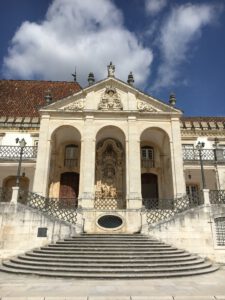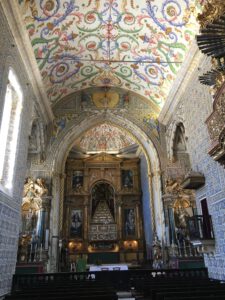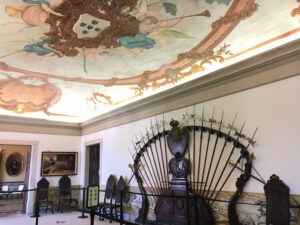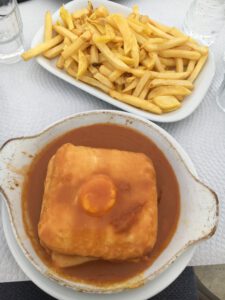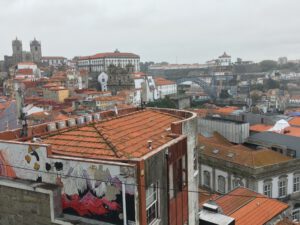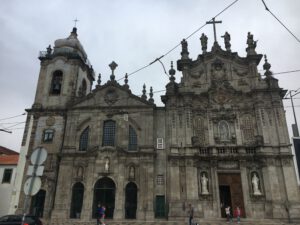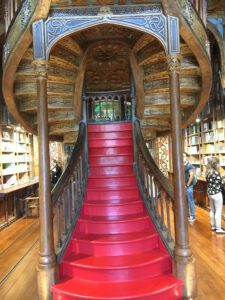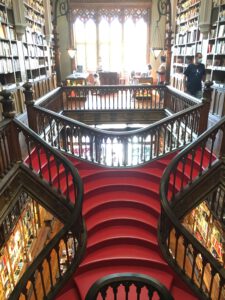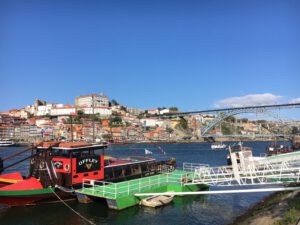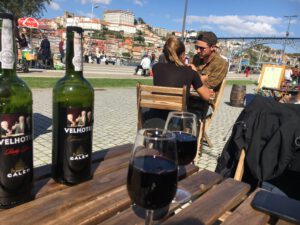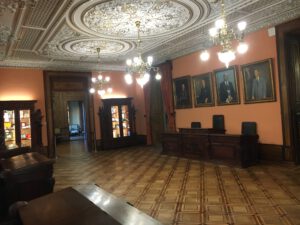Left behind the capital city of Portugal, we headed towards Coimbra. The fourth-largest city in the country, it provides an outstanding example of an integrated university city with the feet firmly planted in the tradition and a gaze to the present. We arrived in the evening and, after a quick dinner, we took the chance to go around and have a look at the night-life. To be honest, I have been surprised to notice that the city seemed a bit dull for a student city. There were not many bars and pubs open, and the few ones available were almost empty. A bit disappointed we retired in the hostel, but yet confident in the many discoveries the city would have reserved for us the next day. We began our day in one of the numerous patisseries this country has to offer (Portugal has plenty of desserts and everyone should try them!!), “Pastelaria Briosa”. Besides the ever-present Pastel de Nata, unavoidable for each meal, and even outside the meals, we tasted the “pastel de Tentugal”, created by the nuns of the monastery do Carmelo de Tentugal, and the “Arrufada de Coimbra” which is very similar to a sweet pan-brioche that can be filled with ham or cheese on request.

After breakfast, we directly went up the hill to visit the University, one of the oldest universities in the world, dating back to 1290. The Baroque Library “Biblioteca Joanina” absolutely deserves a look. The exterior entrance is adorned in baroque style with a Latin inscription encouraging to use books as weapons towards wisdom. Moisture, temperature and insects are the most dangerous enemies for the books, but FUN FACT: there are two colonies of bats, that live and have lived there for as long as 2 and half centuries, who help with pest control. Then we moved to the “Capela de S. Miguel”, the chapel of the university. This is one of the only two remaining royal chapels in Portugal. The white and blue-tiled walls are a distinguishable mark of this chapel. The impressive baroque organ, with more than 2000 tubes, was meant for another much larger church and this is the reason why it is so disproportionate with respect to the chapel, but yet beautiful to see.
Passing by the “Salas das Armas”, the armory (which contains heldberds still used today during academic ceremonies such as the awarding of Honoris Causa doctoral degrees and the swearing of the Rector), one can reach the corridor which runs along the “Salas dos Capelos”, the Great Hall of Acts. Once used as the Throne Room, when the University was used as a king’s Palace, the memories of the glorious past can be still noticed on the walls, where there are portraits of some of the Kings of Portugal. On the benches in the hall only people with doctoral degrees can seat, during academic ceremonies. They have to wear the “borla”, a small hat representing wisdom, and the “capelo”, a hood symbolizing science.
The public can assist these ceremonies from the lower level. The hall is used as well for the defenses of doctoral theses. Before leaving the building, you’ll pass by the “Sala do Exame Privado”, where the exams used to take place. Only the commission composed by professors and the student were admitted to this room during an exam. The students were examined one at a time.
Before leaving Coimbra, we stopped by the new and the old Cathedrals. The facades are really impressive, the Romanic old one resembles a fortress for the defense of the city, the new one with its baroque style is still used today but we could not enter because of a marriage going on. In the end, we left this amazing village to reach Porto. But before that, we couldn’t resist and we tried the typical dish of the zone near the Igreja de Santa Cruz (Another Baroque masterpiece this city has to offer): the Francesinha. The idea is the one of a toast, but inside it contains whatever meat you could imagine: a steak, ham, sausage, bacon, and then cheese, topped with a fried egg and immersed in a sauce of tomatoes and beer. I thought the Portuguese diet was light, more or less like my Mediterranean diet, well I was totally wrong!
Porto did not reserve us the warmest welcome: once arrived it was rainy and windy, cold bit our ankles and wrists, but Porto had the ability to change a bad first impression with a series of unexpected discoveries. Indeed, it is no wonder Porto is called “The Capital do Norde” and the country inherited the name from this city. We had only one day and a half so we started our tour immediately by walking through the “Avenida dos Aliados”. At the beginning of this street, there is the elegant town hall, dominating the “Praça do General Humberto Delgado”. Walking down, this flamboyant route, skirted by buildings adorned with different styles, from neoclassical to French Beaux-art, we reached the station of Sao Bento. The baroque façade and the side walls are dressed up with azuleyos depicting the Battle of Arcos de Valdevez and the Conquest of Ceuta. Inside the station, turning your head left and right and up and down you will remain astonished by the triumph of azuleyos that cover the walls and the ceiling. There are about 20 thousand tiles all over the station. These little pieces of manufacturing are very common all over the city and in the whole country, you will get used to them walking in the little alleys. Before going for dinner at one of our friends’s house (Portuguese people are incredibly hospital) we took the chance to have a glimpse of the river Douro from one of the Miradouro of the city: “Miradouro Vittoria”. Even though it was cloudy, the sight was enchanting.
Waking up after a dinner spent with nice company and good wine it is not always easy, but knowing there were still too many things to try, taste or visit, the mood was flying. The first thing we visit was the “Livraria da Lello & Ivrao”. Rumors are that this place inspired J.K.Rowling for one of the most famous places where she set her novel: Diagon Alley. But this seems to be just a legend and the author publicly denied having ever been in that library. Nonetheless, this place deserves for sure a visit. With its curvy handrails and stairs, the colorful glassy ceiling illuminating all over the books and the old-looking shelves this library will likely bring you in a magic world, and maybe remind you where Harry Potter used to buy his cauldron, wand and gown, and where some of you may have lived their childhood.
Leaving behind this fairy tale place, our feet lead us towards the bridge Dom Louis I. This is surely one of the symbols of the city, it has been built by one of the students of Gustav Eiffel and it sits enthroned above the Douro. Crossing it you’ll actually be in another city, but it’s right on the opposite side of the river where you can sit at one of the bars and taverns, tasting a glass of the finest Port wine produced in town. For the wine lovers, you can even try the tour of the wine cellars, but considering the high alcohol percentage of Port wine, you would probably end up not seeing anything else in Porto after that. We did not try the latter, we just tasted a glass of this vermillion wine.
From the bank, we climbed the hill to reach the “Jardim do Moro” where we took some time to stretch out and relax, glancing at the red-tiled covered roofs of the city on the other side, with its tangle of alleys, lanes and boulevards climbing up the hill and reflecting on the calm surface of the river Douro. We then visited the Cathedral, with its majestic façade, dominating the town, remembering a glorious catholic past and another symbolic church: “Sant’Idelfonso”, an example of the skilled use of the art of azuleyos.
Something surprising was the visit of the “Palacio de Bolsa”, the old stock market. From outside, it just looks like an old grey building where melancholic businessmen following a formal dress code used to spend their days. But, once inside, you can notice how refined was the taste of these ancient businessmen. The spacious and airy entrance hall brings to your mind the images of a lavish past where powerful men used to meet and discuss about affairs under the enormous glassy dome illuminating each corner of the lobby. The dome is framed by a series of coats of arms, each one representing a country which had trading relationships with Portugal. On the second floor, one can visit the decision room, more or less like a tribunal, the telegraph room which was used to communicate with other stock markets around the globe, some chamber of delegation, and in the end the flagship of the building: the Arabic room. This is a sumptuous hall, all adorned with arabesques and geometric forms, just like a mosque. With its gold friezes and wise use of the light thanks to colorful balconies and rose windows the room seems always decorated for parties. Indeed, we discovered that it is always possible to rent one of the halls of the Palacio da Bolsa, for concerts, events and private parties. The renting for the entrance hall, the biggest room available is 10 k euro, while for the Arabic room, which is obviously the most requested one, the price is lower, going down to 7.5 k euro. Think about it for your next birthday…
Before going to dinner, we conceded ourselves a brief stop at the Majestic Cafè. Finally, Harry Potter’s fan like me will be delighted to discover that this city still contains some tracks of the most famous magician in the world. In fact, her majesty, J.K. Rowling spent a couple of years in Porto teaching, and she used to spend time in the Majestic café where she started writing the legendary saga that everyone knows. The place is amazing, and I could understand why she picked that place as her laboratory, eve though it is a bit pricy.
Do not leave Porto without trying the Oporto fashioned octopus or tripe. Before going to bed we decided to go one last time in Praça da Ribeira, on the river Douro to get something to drink. We also found some street performers entertaining us with music, rendering the atmosphere absolutely enchanting. One last advice, if you get tired about SuperBock, the most common beer in Porto, try the ginja in the chocolate glasses, a true stylishness, you won’t regret. But we did regret leaving Porto the day after. I can certainly affirm: I will come back!





